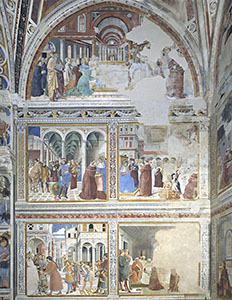
Scenes from the life of Saint Augustine, Chapel of the Choir, Church of St. Augustine, San Gimignano.
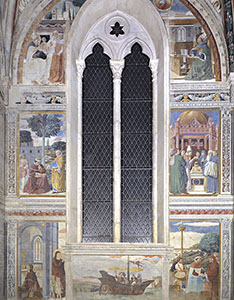
Scenes from the life of Saint Augustine, Chapel of the Choir, Church of St. Augustine, San Gimignano.
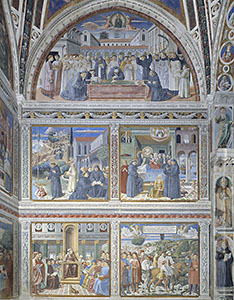
Scenes from the life of Saint Augustine, Chapel of the Choir, Church of St. Augustine, San Gimignano.
Having left Florence due to the plague that struck the city in 1463, Benozzo Gozzoli headed for the town of San Gimignano in the hope of escaping the terrible epidemic since many people then believed hill-top towns to be safer.
The painter had already created what critics believe to be one of his most prestigious works, namely decoration of the entire chapel in the Medici Palace on Via Larga (now Via Cavour) in Florence, commissioned by Piero de' Medici in 1459. This engagement proves that Gozzoli was already an established artist. However, due to the private nature of the work, it did not display the full extent of his talent to his contemporaries. For this reason, his first great work to achieve fame during that time was the cycle of frescoes he painted, with the help of some co-workers, in the Church of St. Augustine in San Gimignano.
This church has a single nave with a timber truss roof and is completed by a quadrangular chapel flanked by two smaller chapels, also with a square plan. It was built at the wish of the Augustinian Fathers between 1280 and 1298, after Pope Alexander IV officially recognised the Order of the Hermit Friars of St. Augustine in 1256.
Benozzo received the commission to fresco certain episodes in the life of the Saint from Fra' Domenico Strambi, a learned Augustinian monk of the convent who had obtained patronage of the main chapel from the Dietiguardi family. Strambi almost certainly dictated the complex iconographic programme, partly due to the problems the convent was experiencing at that time. Indeed, the Order had lost its genuine observance of the precepts dictated by the Rule at the time of its constitution. This cycle of frescoes marked the beginning of a long phase of transformation for that religious community, which resulted in the Convent of San Gimignano to adhering, from 1481, to the Rule of Observance set out by the Augustinians of San Salvatore in Lecceto, Siena, a very famous spiritual centre advocating from 1387 the Observant Reform Movement.
In addition to Strambi's instructions, when illustrating the stories, Benozzo may also have drawn inspiration from the cycle with a similar subject frescoed by Ottaviano Nelli in the church of St. Augustine in Gubbio, which he had probably became familiar with during his earlier stay in Umbria. This is supported by the testimony of Vasari who, during Benozzo's lifetime, mentioned possessing a complete series of drawings of the Augustinian stories produced by Benozzo himself. Indeed, it was customary for artists to create drawings by copying what they observed elsewhere. These models were then revised and used as a kind of sample to show to their clients and, at the same time, a guide for the painters themselves during the various stages of their work, although changes may have been made while the work was in progress.
Benozzo was required to decorate pre-existing architectural surfaces with a clearly Gothic style. However, he was able to match the venues to his paintings using a device often seen in his work, namely trompe l'oeil sculpted decorations with Classical motifs and separation of the scenes with string-course cornices, with the entire fresco set on a base of trompe l'oeil marble panels. These were in full Renaissance style (coherent, therefore, with the language of the frescoes themselves), thus achieving complete unity between the architecture of the chapel and the painting that decorated it.
The cycle consists of a total of sixteen scenes from the life of Saint Augustine. In his depiction of them, Benozzo undoubtedly enlisted the help of Father Strambi, a person of the highest intellectual and spiritual standing who had spent time in Paris from 1450 to 1457, gaining his degree in Theology at the Sorbonne. Strambi must, therefore, have been an expert in Augustinian literature, from the book by Possidius (disciple and friend of Saint Augustine and author of his biography based on personal memories and written sources from the library in Hippo) to the Confessions, the Saint's most famous work, written between 397 and 401. Some episodes, on the other hand, are taken from Jacobus de Varagine's Golden Legend and other stories about the life of the Saint are clearly quoted from Cyril of Jerusalem's Apocryphal Letter.
The narration begins with the frescoes at the bottom of the left-hand wall and proceeds to the right in the same register.
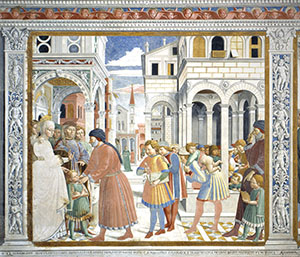
Saint Augustine Starts School in Thagaste, Church of St. Augustine, San Gimignano.
Scene 1. Saint Augustine starts school in Thagaste
Augustine was born in Thagaste (Numidia, North Africa) in 354 to a pagan father and a Christian mother, Monica. This scene, according to a custom followed since the Middle Ages, depicts several episodes: Augustine accompanied to school by his mother and the boy attentively studying a tablet with Greek letters engraved on it. This image is intended to demonstrate Augustine's learning and, in particular, the importance of his studies of Classical literature, which he himself describes in his Confessions. Another significant element in this scene is the teacher punishing a schoolboy. The source, here, is once Augustine himself who always remembers the corporal punishment inflicted at school with displeasure.
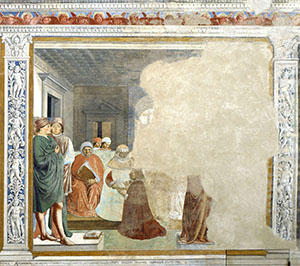
Admission of Saint Augustine into the University of Carthage, Church of St. Augustine, San Gimignano.
Scene 2. Admission of Saint Augustine into the University of Carthage
Augustine went to Carthage to continue his studies. This particularly damaged image illustrates his admission to the University, where he studied Liberal Arts, read Cicero's Hortensius (an exhortation to philosophy) and sought knowledge in the Holy Scriptures, though he was always distracted by the pleasures of literature.
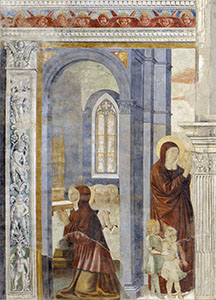
Prayer of Saint Monica, Church of St. Augustine, San Gimignano.
Scene 3. Prayer of Saint Monica
Augustine became an active advocate of the Manichaean doctrine, a school of thought founded by the Persian Mani (216-273) which declared itself to be a perfection of Christianity and therefore claimed to explain the origin of evil, attributing creation to a cruel god and absolving man of all responsibility for sin. This came as a disappointment to his mother who, as depicted in this scene, wept and prayed for him. Also portrayed are her dream and her meeting with the Bishop, which gave mother hope, after which Augustine began to doubt Manichaeism, particularly due to certain holes in this philosophy which "destroys everything without creating anything".
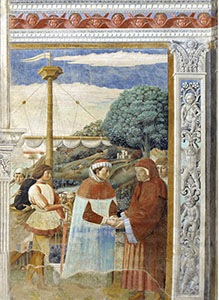
After meeting Faustus of Mileve, Saint Augustine decides depart for Ostia, Church of St. Augustine, San Gimignano.
Scene 4. After meeting Faustus of Mileve, Augustine decides depart for Ostia
This scene has been interpreted as Augustine's arrival in Ostia, but it could perhaps illustrate the Saint's meeting with the learned Faustus of Mileve. No-one to whom Augustine voiced his doubts about the Manichean philosophy knew what to answer except to promise the arrival of Faustus who, however, did not succeed in convincing Augustine of the wisdom of Mani's doctrine. In 383, therefore, Augustine left for Rome.
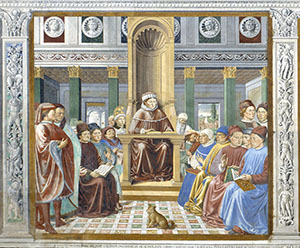
Saint Augustine Opens a School of Rhetoric in Rome, Church of St. Augustine, San Gimignano.
Scene 5. Augustine opens a school of rhetoric in Rome
In the Italian capital, the Manichaeans cared for him during a serious illness and helped him to open a school of rhetoric. In this scene, Augustine is depicted sitting at a teacher's desk. He did not, however, receive any payment for the courses he taught. His friends then introduced him to the Prefect of Rome, who appointed him Professor of Rhetoric in Milan. After various episodes that occurred during his stay in Rome, Augustine detached himself completely from Manichaeism, having tested its limits and found its hidden failings.
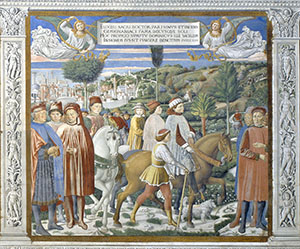
Saint Augustine Departing from Rome for Milan, Church of St. Augustine, San Gimignano.
Scene 6. Augustine departing from Rome for Milan
Benozzo illustrated Augustine's journey to Milan as it is described in the Confessions: a pilgrimage by the young man in search of the right faith. Above the procession, two angels hold up an inscription naming the client of the cycle, Benozzo himself and the date of the work. In the background is a view of Rome in which the Pyramid of Cestius and the Pantheon are clearly visible. As in the cycle he had previously frescoed in the Medici Palace in Florence, Benozzo included some figures from contemporary social and ecclesiastical circles in the decoration. He also painted his own portrait, in the right-hand border dressed in red. This was probably the last scene he ever frescoed.
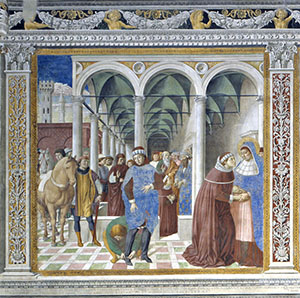
Saint Augustine Arrives in Milan, Church of St. Augustine, San Gimignano.
Scene 7. Augustine arrives in Milan
This scene depicts the Saint's arrival in Milan, where he was welcomed by Bishop Ambrose. During his time there, Augustine learned about neoplatonic philosophy, which helped him to abandon Manichaeism completely and seek truth in Christian doctrine. To create this scene, Benozzo combined three consecutive episodes relating to this event, making skilful use of the architectural backdrop to position the different sections, namely Augustine assisted by a servant in removing his riding clothes, the Saint on his knees before Emperor Theodosius and, finally, his meeting with Saint Ambrose.
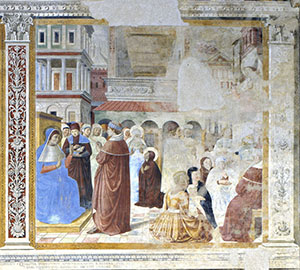
Saint Augustine Hears Ambrose Preach, Church of St. Augustine, San Gimignano.
Scene 8. Augustine hears Ambrose preach
"That man of God welcomed me like a father and appreciated my pilgrimage like a true bishop. […]. I attended his public teachings diligently, though not for the right reasons; in reality, I wanted to satisfy myself as to whether his eloquence was deserving of the fame it enjoyed, or whether it was greater or lesser." These were the words of Augustine and, undoubtedly, the ones to which these three illustrated episodes refer. On the left, Augustine listens to the Bishop's preachings. The right-hand side, where the fresco is unfortunately most damaged, probably depicts Augustine's interview with Bishop Simplicianus (Ambrose's successor), during which he learned of the conversion of the famous neoplatonic rhetorician Victorinus. In the centre is the figure of his mother Monica, who had travelled to Milan hopeful of finding her son converted to Catholicism. The depiction of Saint Monica praying before Ambrose is intended as a testimony to her obedience and devotion to him, as recounted by Augustine himself in his Confessions.
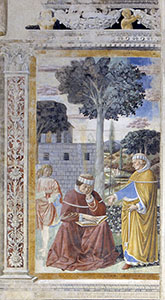
Saint Augustine Reads the Epistle of St. Paul to the Romans and is Converted, Church of St. Augustine, San Gimignano.
Scene 9. Augustine reads the Epistle of St. Paul to the Romans and is converted
As he tells in his Confessions, Augustine was deeply regretful about the dissoluteness of his former lifestyle but was not yet ready to embrace his new faith unconditionally. While in a garden, he heard a voice that repeatedly sang "Take and read, take and read": an exhortation which the Saint interpreted as command from God to open the holy book. Benozzo, faithful to the story, painted Augustine meditating on the Holy Scriptures accompanied by a little girl and a little boy, since the Saint, as he himself wrote, was never able to decipher whether the voice that exhorted him to read was male or female.
Opening the Bible at random on Saint Paul's Epistle to the Romans, Augustine felt a certainty that he had not found elsewhere for a long time, and discovered his deep faith in God.
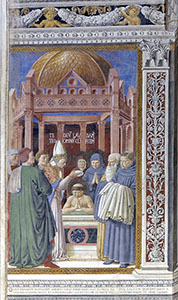
The Baptism of Saint Augustine, Church of St. Augustine, San Gimignano.
Scene 10. Baptism of Augustine
In this episode, Augustine is kneeling in prayer in a Baptistery, behind a marble sarcophagus filled with water bearing an inscription of the date on which the scene was painted. Behind him is his mother, Monica, while the figure on the right (the clergyman holding the Saint's clothing) has been identified as Domenico Strambi who commissioned this cycle of frescoes.
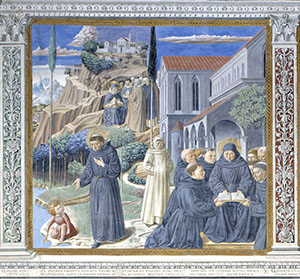
Some Legends about Saint Augustine, Church of St. Augustine, San Gimignano.
Scene 11. Some legends about Augustine
This scene depicts some episodes from the life of the Saint which are not mentioned in his Confessions. His interview with the Child Jesus about the Parable of the Holy Trinity is narrated in an apocryphal letter from Cyril of Jerusalem which recounts that, while Augustine was meditating on the Holy Trinity, he met a little boy who was trying to collect all the water from the sea with a spoon. When Augustine attempted to explain the impossibility of this task to the child, the latter replied that neither could the Parable of the Holy Trinity be comprehended by the human mind.
The second episode depicted is Augustine visiting the monks of Mount Pisano and dictating the Rule. This episode is not described in any sources and is depicted for the first time in this fresco. The scene is intended to highlight the importance of the Augustinian Order based in Tuscany and to reassert the ancient tradition according to which it was in that very area that this monastic order originated. There is no historical evidence of Augustine's stay in that region but only a legend passed down by word of mouth according to which the Saint had passed through after the death of his mother and, because of his terrible grief, he forgot to include the episode in his writings.
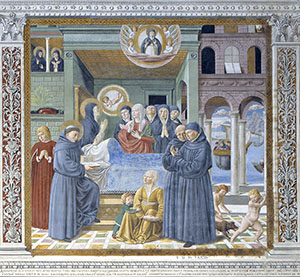
Death of Saint Monica, Church of St. Augustine, San Gimignano.
Scene 12. Death of Saint Monica
While returning to Carthage, Augustine's mother fell ill and died in Ostia. This scene depicts Monica's body laid out on a bier while her soul is carried up to Heaven in a small glory of angels. By her deathbed are Augustine, his younger brother and other bystanders. Among them, Fra' Strambi is depicted once again. The Saint decided to continue on his journey back to his country of birth.
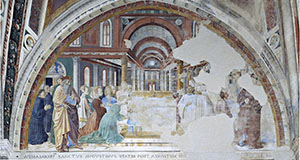
Saint Augustine, Appointed Bishop, Blesses the People of Hippo, Church of St. Augustine, San Gimignano.
Scene 13. Augustine, appointed Bishop, blesses the people of Hippo
Augustine returned to Thagaste, gave his belongings to the poor and, with the help of some friends, founded a monastic community with which he returned to Hippo where, at the age of forty-two, he was appointed Bishop. In this scene, Augustine is depicted in a church in the act of blessing the faithful. Here, once again, Benozzo succeeded in reproducing elegant Renaissance architecture without neglecting the sophistication of the details, such as the lunette above the door in the left-hand margin of the panel: a clear allusion to terracotta work in the style of Robbia.
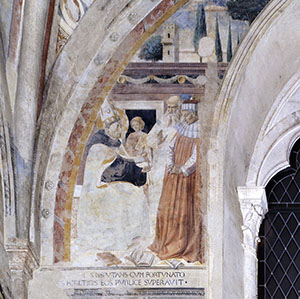
Dispute with the Heretic Fortunatus, Church of St. Augustine, San Gimignano.
Scene 14. Dispute with the heretic Fortunatus
This episode is from Jacobus de Varagine's Golden Legend and is a testimony to Augustine's numerous conversions and his victorious battle against heresy. According to the story, the Saint was called upon by some Christians to debate questions of faith with a Manichaean priest by the name of Fortunatus who was preaching in Hippo at that time. Augustine won the dispute, obliging the heretic, who was unable to refute the Christian arguments, to withdraw.
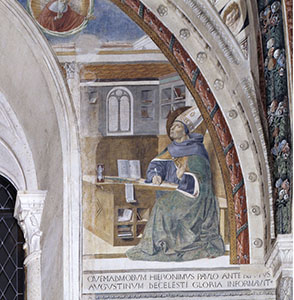
Saint Augustine’s Vision of Saint Jerome, Church of St. Augustine, San Gimignano.
Scene 15. Augustine's vision of Saint Jerome
In this scene, Benozzo depicted Saint Augustine surprised by the voice of Saint Jerome, who warned him of his imminent ascent to heaven while he was writing a letter. Here, Augustine is portrayed in the garb of a humanist scholar, since he succeeded in reconciling faith in God with science. The iconography of the Saint, depicted in a small studio, was later taken up again by very famous painters such as Sandro Botticelli (1445-1510) and Vittore Carpaccio (1464-1526 approx.).
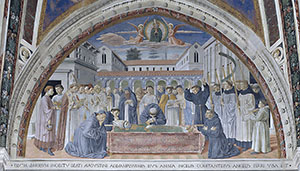
The Funeral of Saint Augustine, Church of St. Augustine, San Gimignano.
Scene 15. Augustine's vision of Saint Jerome
Augustine died in the year 430 at the age of seventy-six in Hippo, as the city was under siege by the Vandals. The composition of this scene is reminiscent, in some ways, of the fresco of the Death of Francis which Benozzo painted for the church of Montefalco. The bier on which the Saint's body lies is adorned with a fine cloth which, once again, highlights Benozzo's technical mastery through his wonderful rendering of the painted fabric. Recognisable in the architecture that serves as a backdrop to the episode is the Ospedale degli Innocenti, an orphanage in Florence designed in 1419 by Filippo Brunelleschi (1377-1446).
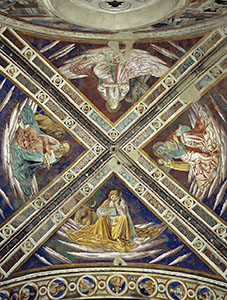
Detail of the vault depicting the Four Evangelists, Church of St. Augustine, San Gimignano.
Conclusions
Saint Monica plays an important role in this fresco, being Saint Augustine's mother and, above all, the one who was concerned about his spiritual development. Also, at the time these frescoes were painted, worship of Saint Monica had been given a new lease of life by the transfer, in 1455, of her relics from Ostia to Rome where they were placed in a magnificent chapel in the church of St. Augustine.
All the episodes are easily recognisable thanks to the Latin inscriptions that provide a thorough commentary below each panel. In the episode illustrating Augustine departing from Rome for Milan, probably the last to be painted, a tablet upheld by two angels bears the name and title of the client (known as the "Parisian Doctor" having studied at the Sorbonne) and an acknowledgement of his patronage of this work, which he commissioned from Benozzo in 1465.
The cycle concludes with the Evangelists, depicted with their customary attributes, in the four webs marked out by the ribs of the cross-vaulted gothic ceiling, while the intrados of the chapel houses the Apostles in twelve medallions, and a Christ in the act of blessing is depicted on the keystone. The pillars are frescoed, both on the inner side and on the side overlooking the nave, with the figures of saints set within painted Renaissance-style niches. As well as Saint Monica, these include popular local Saints Fina and Bartolo, Saint Nicholas of Bari and Saint Sebastian, considered some of the protectors of the place, and Saint Gimignano himself, depicted according to iconographic tradition, holding up a model of the towered city.
This cycle became one of the masterpieces of Augustinian iconographic narrative, and the only one in Tuscany. Its excellence lies not only in Benozzo Gozzoli's creative talent, based on the idea of varietas dictated by the precepts of Leon Battista Alberti, but also and above in the painter's ability to illustrate real, existing urban areas inspired by places in Florence and Rome that were famous at that time.
Serena Nocentini